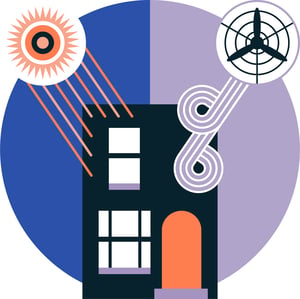The House in a Lab at the Forefront of Energy Efficiency
It’s a regular two-up two-down of the kind you might find in any town or city in England, full of the usual appliances and furniture. But with one big difference: this Victorian era terraced home has been rebuilt inside a Salford University laboratory and is at the cutting edge of research into home energy efficiency.
The aim of creating the Energy House back in 2011 was to provide a controlled environment to investigate home energy use and how to improve energy efficiency across the UK. It’s a hub for research and for businesses to test out their products in a controlled environment.
Wasted energy makes up 30% of the average energy bill - do something about it! Get more from your smart meter with Loop.
It’s built inside an environmental chamber which can simulate the sun, wind, snow and slanting rain. Alongside its home comforts and fully functioning appliances are hundreds of sensors - alongside Loop devices to measure energy use.
It can even replicate human activities that impact on a home’s energy efficiency, such as the opening and closing of doors, windows and appliances.

Older Homes in Need of an Upgrade
Professor Will Swan, Director of Energy House Laboratories at Salford University, says: “The idea behind the Energy House was to find out what can people do to their homes to make them more energy efficient, ranging from retrofitting the whole house, to things like thermostatic radiator valves and heating controls. In a normal environment, it’s difficult to get evidence about how things work.”.
Turn-of-the-century terraces like the Energy House simply weren’t built with energy efficiency in mind. So, many older homes are in urgent need of improvement to become more energy efficient, helping people reduce their bills and create a comfier, warm home.
He explains: “Understanding how things fit together as a whole house is really important - if you test something like a boiler, for example, you see how it interacts with all sorts of other things like the fabric, the radiator, the controls."
In one early experiment, the house underwent a typical retrofit; with measures including double glazing, wall, loft and floor insulation. The aim was to demonstrate the potential for big reductions in heating by using off-the-shelf products. “We reduced the heating energy by more than 60%” Professor Swan says.
Such retrofit measures can cost £15,000 to £16,000, the Salford University team point out. But big investments and retrofits aren’t always needed, and much of the research carried out in the lab has focused on how much can be saved through behavioural change.

Beyond a Terrace
The type of terraced home used for the Energy House lab accounts for about a fifth of the UK’s housing, so there’s much more to be done to investigate home energy efficiency.
So, the team at Salford University are creating Energy House 2.0, where all sorts of buildings can be constructed, tested and demolished with the aim of helping improve energy efficiency and create smart homes and the UK and beyond.
It’s also not just about the type of house, and evolving technology is dramatically changing the energy system. Professor Swan says: “We’re getting into much more complicated territory where, for example, the price of electricity may go up and down during the day, we may have a battery and renewables, and rather than just consume electricity, we may store it and sell it later.”
Such changes are part of a shift towards an energy system that is less dependent on the grid and moves away from fossil fuels. This smart energy revolution will be a key part of the solution to meeting UK targets including a ban on the sale of new petrol and diesel cars by 2035, and the broader 2050 net-zero carbon target.
Projects like the Energy Houses are going to play a major role in reshaping how energy is used, consumed and generated in the UK.
• • •
Cut Your Energy Bill With Loop
Loop is a FREE energy-saving app that links to your smart meter, analyses your energy use and shows you easy ways to save. On average, Loop users cut their energy use by 15%! How much could you save?








